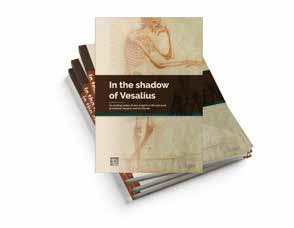
Clicking on this image will download a
PDF file with the book information
This is a new, as yet unpublished, book authored by several of my good friends who with me follow Vesaliana all over the world. There are too many of my friends to count, but I highly recommend this book. Dr. Miranda
In this richly illustrated book, a multitude of academic scholars present new findings concerning Andreas Vesalius Bruxellensis and his contemporaries. One of those discoveries includes a preparatory sketch by Jan Steven van Calcar for a drawing in Vesalius’ famous ‘Fabrica’, called ‘The Philosopher’.
Included are authentic letters, written by Vesalius to his friends Benedetto Varchi and Octavo Landi, are presented and translated for the first time and are thoroughly discussed, shedding new light on crucial periods of Vesalius’ life like his leave from academic Padua, exchanged for imperial service to Charles V, or his contribution in the treatment of Philips II’s son, crown prince Carlos in Spain.
Anatomical novelties, discovered by Vesalius’ friends and contemporaries, are equally broadly exposed, like Canani’s input in human arm musculature or Valverde’s ‘corrections’ of Vesalius’ Epitome. Valverde’s publication became one of the greatest ‘bestsellers’ in anatomy during the 16th and 17th century, thereby spreading the ‘Vesalian Revolution’ all over Europe. But also, the relationship between Vesalius and his Paduan room mate John Kay or Caius is explicated, as are a number of family descendants of Vesalius.
That Vesalius influenced artists in anatomical models and drawings is newly acknowledged in this book, as well as his influence on veterinary medicine.
In short, an inspiring new account of Vesalius’ extraordinary long-term influence on anatomy, science and art in general. One interesting point is that until now, many of the series of articles that composes the book where only available in Greek!
Jacqueline Vons (Emer. Professor of Latin and Medical History, University of Tours, France) comments "Centered around the figure of Andreas Vesalius (1514-1564), this book ‘In the Shadow of Vesalius’ offers a vast panorama of the anatomical knowledge in Europe during early Modern times.
Some new documents and private letters have been discovered and are finely analyzed, as are anatomical books written by contemporaries and successors of Vesalius. The studies gathered here show how the text and iconography’s diffusion of De Humani Corporis Fabrica and Epitome made Vesalius the first modern medical authority (auctoritas): his work was quoted, copied, discussed by all those who were interested in the anatomy of the human body."
Click here to download a PDF file with a description of the book, the Table of Contents, and the information to pre-order this book which will be launched on November 14, 2020. To order a book at a pre-launch discounted price, you can go directly to the publisher's website (http://garant.be/shadow-of-vesalius/).
Pascale recently wrote an article looking back at how this book came to be. Here is the story of "The Long Road to the book "In the Shadow of Vesalius"




